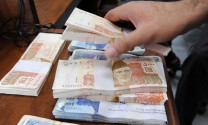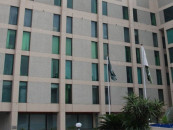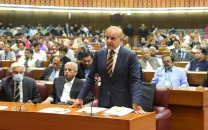Savings mobilised record 137% hike, read at Rs229.9b
Largest jump witnessed in November when SBP cut interest rate.

The largest jump in NSS mobilisation in the seven months was witnessed in November when NSS received over Rs90 billion. STOCK IMAGE
According to the latest data released by the State Bank of Pakistan (SBP), savings mobilised under the NSS in January alone amounted to Rs34.4 billion, which is 11.1% less than the corresponding figure for the same month of the last fiscal year.
The largest jump in NSS mobilisation in the seven months was witnessed in November when NSS received over Rs90 billion. It was the same month when the SBP brought down its key interest rate by 0.5% after keeping it flat at 10% for over a year. The SBP decreased its key interest rate by a total of 1.5% during the period under consideration.
The government has linked profit rates on major NSS with the yield on Pakistan Investment Bonds (PIBs). PIB yields have come down notably since January. In the latest auction, the cut-off yields on three-five- and 10-year PIBs came down by 39, 60 and 20 basis points, respectively.
As a result, the federal government has also reduced the rates of return on various schemes by 1.2%-1.5% from February 1.
Speaking to The Express Tribune, Emerging Economics Research Managing Director Muzammil Aslam said NSS profits will go down further in case the central bank reduces the key interest rate in the upcoming monetary policy announcement.

While some of the savings schemes impose an upper cap on the total amount of investment one customer can make, other schemes such as National Savings Bonds do not entail such restrictions. Aslam said big investors can possibly pull out their investments if yields on PIBs, which loosely serve as a benchmark for most NSS, decrease further in coming months.
Savings mobilised under the NSS in 2013-14 amounted to Rs196.4 billion, which was almost half of the savings mobilisation achieved during 2012-13.
Savings mobilisation under the NSS remained Rs224.7 billion in 2009-10, Rs234.9 billion in 2010-11, Rs188.3 billion in 2011-12, Rs386 billion in 2012-13 and Rs196.4 billion in 2013-14. This translates into a compound annual growth rate of a negative 3.3% per annum for the last four fiscal years.
High mobilisation of savings under the NSS is not necessarily a good phenomenon. Government borrowings under the NSS are categorised as ‘unfunded debt’ and should thus be minimised.
According to the Ministry of Finance, the government’s unfunded debt stood at Rs2.6 trillion at the end of 2014. Its share in the government’s total domestic debt currently stands at 22.3%.
Published in The Express Tribune, March 5th, 2015.
Like Business on Facebook, follow @TribuneBiz on Twitter to stay informed and join in the conversation.


















COMMENTS
Comments are moderated and generally will be posted if they are on-topic and not abusive.
For more information, please see our Comments FAQ